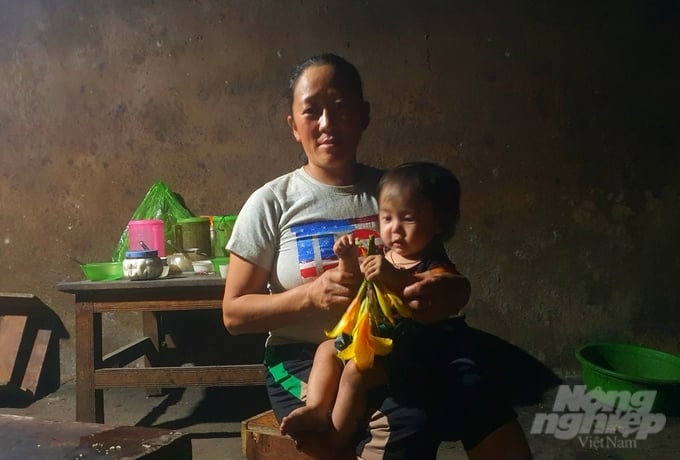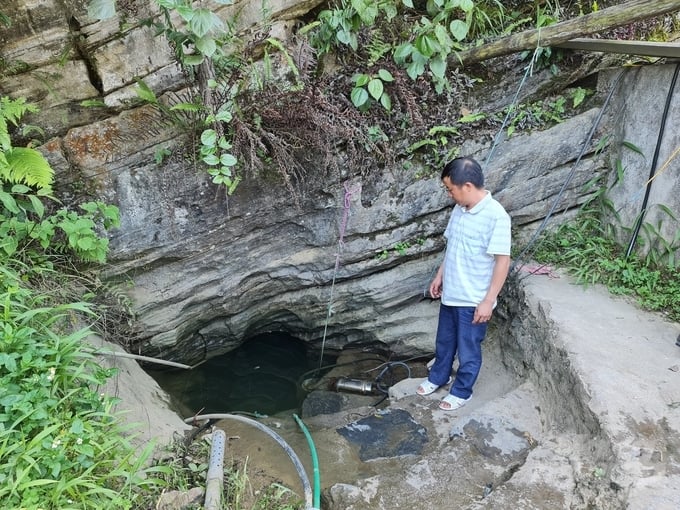May 24, 2025 | 16:21 GMT +7
May 24, 2025 | 16:21 GMT +7
Hotline: 0913.378.918
May 24, 2025 | 16:21 GMT +7
Hotline: 0913.378.918

Stone fences in Ha Ia village, Can Chu Phin commune. Photo: Kien Trung.
Lau Thi Lua carried a gui (a type of weaved basket of the Hmong) filled with grass, holding the small child in her hand, followed by the disabled brother of her husband, walking slowly up the slope of Ha Ia village, Can Chu Phin commune. Lua just returned from the field.

Lau Thi Lua, a Hmong girl who lost her youth at the fair. Photo: Dao Thanh.
Lua has been a bride in Can Chu Phin for 8 years. It was the spring fair in Lung Pu, Lua was young at that time, eager to go out and play. But Vu Mi Sinh and his friends caught Lua and forced her to be his wife. Since then, Lau Thi Lua's youth seems to have been lost at the fair that spring.
8 years just pass like that. Lua's children grow, carefree like corn kernels that had been peeled and germinated on the rocky plateau. When she has two children with Sinh, one is 6 and the other is 4, Lua is no different than a mother chicken tied to a pillar so that her cubs could wander around.
A few years ago, when her husband's parents were still healthy, their legs did not get tired and their backs didn't hurt, so they can work in the fields. But now they are old, mainly at home taking care of pigs, chickens as well as their grandchildren, Lua alone takes care of all the corn fields, sowing 10 kg of corn seeds to cover them all.

Lau Thi Lua and her daughter. Photo: Kien Trung.
In recent years, the Hmong people’s custom of catching the wife is no longer the same as before. If the wife is caught, it is actually the men and women have known and loved each other, and they agree to be together. Going to many village conferences and listening to the information of police officers, the people now know that if the woman does not agree, the man cannot take her back to be his wife because that is breaking the law and he will be severely punished by the State. Even if the parents exchange many buffaloes or cows, the man will not be able to get out nor he will be spared.
Lua’s family has 6 sisters, and Lua is the oldest. Lua's younger sisters can go to school, they won't have to get married as soon as her sister. They will be able to think about the future, as far as the teacher in the lowlands teaches. Lua is sad.
Can Chu Phin is one of 6 communes in Meo Vac district without water source, one of the poorest communes in Meo Vac district. Without water, even if people think of many economic models to eliminate poverty, there is nothing they could do.
According to Lau Mi Va, Deputy Secretary of the Party Committee of Can Chu Phin, the commune has 12 villages, 1,257 households, approximately 7,000 residents. The poverty rate is up to 70%. In order to help people eliminate poverty, many officials and engineers of the province and central government have brought many crop varieties for Can Chu Phin's people to plant, from hybrid maize to rapeseed. Although hybrid corn can be grown, the variety used is susceptible to pests and cannot be preserved for long.
Many villages soon realize that hybrid maize is not suitable for the mountain’s harsh climate with little rain and lack of land as the crop only yields small corn and few kernels. So, the traditional maize variety stayed with the Hmong people.

Water cave in the mountain, the main source of water supply for Ha Ia villagers. Photo: Dao Thanh.
Over the past few years, Can Chu Phin has advocated for tourism based on the traditional culture of the Mong people, especially making full use of the unique features of the stone fences, combined with policies, technical transformation in livestock farming and crop production. Thanks to these changes, hunger and poverty are gradually pushed away.
“The State has already taken care of the people by making such a great road, supporting poor households with health insurance and seedlings. Now is the people’s to actively think about helping the State, helping themselves. In the next few years, officials said that they will build a route to serve the marathon running on the rocky plateau, including the section through the village. So the villagers must work with the construction staff to decorate their houses and promote tourism. When the economy is more developed, more tourists from the lowlands will gradually help enlighten the people in the Hmong village, from which the old and outdated customs in Can Chu Phin can slowly become a story of the past,” said Ho Pa Lua, head of Ha Ia village.
Translated by Samuel Pham

(VAN) The People's Committee of Tra Vinh province has approved an adjustment to the investment policy for the Green Hydrogen Plant project, increasing its area to approximately 52.76 hectares.
![Reducing emissions from rice fields: [2] Farmers’ commitment to the soil](https://t.ex-cdn.com/nongnghiepmoitruong.vn/608w/files/news/2025/05/05/dsc08881jpg-nongnghiep-140632.jpg)
(VAN) Clean rice cultivation model in Thuong Tan commune, Bac Tan Uyen district, is assisting local residents in achieving sustainable agriculture by substantially reducing costs, increasing productivity, and protecting the environment.

(VAN) At the conference to disseminate Resolution No. 68, AgriS introduced its digital agricultural ecosystem and reaffirmed its commitment to accompanying the Government in promoting private sector development and sustainable agriculture.

(VAN) 'Blue Ocean - Blue Foods' initiative is designed to restore marine ecosystems and establish sustainable livelihoods for local communities by cultivating a minimum of 1,000 hectares of cottonii seaweed in the first three years.
/2025/05/21/4642-3-112707_603.jpg)
(VAN) The V-SCOPE project has made direct contributions to three out of six pillars of the Comprehensive Strategic Partnership between Vietnam and Australia.

(VAN) Facing the threat of rabies spreading to the community, Gia Lai province urgently carries out measures to vaccinate dogs and cats on a large scale.

(VAN) Disease-free livestock farming not only protects livestock herds but also stabilizes production and livelihoods for many farmers in Tuyen Quang.